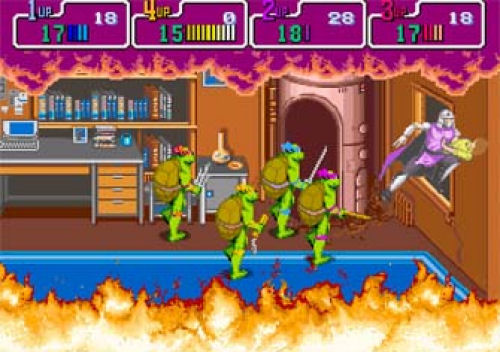
The successful application of co-op in amusement, after the golden-age of arcades, would now be in the hands of the Japanese amusement factories.
With the Japanese amusement game explosion, the application of technology brought color and fast pace game play to the arcades. Capcom re-invented the ‘shoot-em-up’ genre with games such as ‘Side Arms’ (1986), with a simultaneous 2-player action that encouraged occasional co-op behavior. But it was with ‘Forgotten World’ (1988) that the co-op shoot-em-up hit new heights, with an amazing blaster, levels only complete-able if the players’ cooperated.
As Atari in America snoozed, Capcom in Japan grasped the co-op nettle – adding simultaneous play element to the ‘slash-em-up’ ‘Magic Sword’ (1990) – a side scrolling sword and sorcery battling game that offered "2-player interactive" – the language that the Japanese used to describe co-op; with a sequel 3-player version called ‘Knights of the Round’ (1992). And with this Capcom would go on to create a series of side-scrolling ‘interactive’ games – most notably ’Final Fight’, ‘Three Wonders’ and ‘MERCS’.
Taito is another of the Japanese factories that pushed the design envelope, creating games that re-established genres with added elements – titles such as ‘Double Dragon’ (1987) that had 2-players working as a team in this ‘beat-em-up’, cooperating to defeat hoards of opponents. The co-op element in the platform game genre was best illustrated by the title ‘Bubble Bobble’ (1986) – a game that offered both fun and unique action, with enjoyable interactive play to complete each level.
Other Japanese amusement factories that left their mark in the co-op scene includes Konami; a company that flirted with the 2-player narrative that included a co-op element, along with earlier titles, games such as ‘Devastators’ (1988) and its unusual second person on rushing combat action saw both players able to support each other – more tradition 2-player slash, shoot and beat em-up titles followed with a co-op flavor – games such as ‘Missing Action’ (1989) or ‘Super Contra’(1989) continued the interactive ‘buddie movie’ style game-play.

It was however following the success of the multiple player experience that Konami broke the mold – the 4-player side scrolling beat-em-up title ‘Teenage Mutant Ninja Turtles’ (1989) that created a co-op genre of its own. The fast action and cartoon representation found an audience. Konami milked the application next with ‘The Simpsons’ (1991) and its 4-player interactive, that also included the new element of combination-moves (two characters able to join together for greater effective attack). This genre was surmounted with the large cabinet ‘X-Men’ (1992), a huge dual-screen 6-player interaction game with super hero characters.
As the performance of arcade technology grew so did the imagination of the developers, Japanese manufacturer SEGA re-visited the slash-em-up genre with a new twist on the co-operative angle; launching the game ‘Golden Axe’ (1989), a title that included play elements that fed off the co-op element and created an enjoyable experience.
With the application of 3D (polygon) graphics and the player was treated to a new gaming environment – and with this new genre applications – so we see 2-player shooting games that allowed (if the players wanted) co-op elements, such as with ‘Virtua Cop’ (1994). Another major amusement factory, Namco, created their own shooter with a major co-op component – ‘Time Crisis 2’ (1997) including a corporative storyline and 2-player game structure.
We move towards the modern amusement scene and the current development of the video amusement in the market.